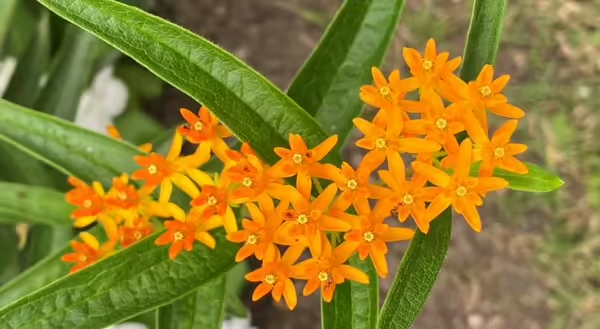
Roadsides and ditches are drawing the eye of humans and butterflies alike as common milkweed plants (Asclepias syriaca) return to the summer scenery. While this plant proves unpopular for its weedy habit, it is a necessity for the monarch butterfly (Danaus plexippus) as the sole food source of the monarch caterpillar. The good news is, with twenty-two species of milkweed native to Illinois, every gardener can find a favorite alternative to common milkweed. No matter the size, sun exposure, or moisture level of your garden, there is a perfect milkweed for that spot, allowing you to grow the plants that support the monarchs, our beloved state butterfly.
The butterflies use chemical and visual cues from their sensory organs to identify milkweed plants. The female butterflies typically lay their eggs on the milkweed leaves ensuring young larvae have an immediate food source once they hatch. Larvae (caterpillars) eat foliage for about two weeks, eating about 200 times their birth weight. With energy stored, the caterpillars find a nearby spot to form into a chrysalis; inside a magical transformation occurs in 10 – 14 days, with a gorgeous monarch butterfly emerging from the shell. Hungry adults will visit the milkweed flowers for nectar but will also frequent other nearby flowers that are high in nectar.
Milkweeds are herbaceous perennials, dying down to the ground each winter and regrowing new foliage each spring. Most milkweed species contain a milky, white sap that exudes when the plant is cut open. All parts of the plant contain toxic compounds, cardiac glycosides, which the monarch butterfly has developed adaptations in order to ingest it. In their short stint of feeding on milkweed, caterpillars will consume enough of the toxic compounds to deter birds (and small mammals) from eating them as adult butterflies. The compounds are present at high enough rates, in monarch butterflies, to be both distasteful, and toxic, to predators.
Milkweed flowers contain high levels of nectar and are a favorite food source for all local pollinators. Flower colors vary from species to species but can be pink, purple, red, white, green, or orange. Mature flowers turn into pods of seeds that are attached to white, fluffy floss which is easily dispersed throughout the landscape by wind.
A huge patch of milkweed is not necessary to benefit the monarchs, a small patch can be a great resource. Consider planting multiple species for season-long support of the monarch because each species has a distinct phenology and bloom time. Species to consider are butterfly weed (Asclepias tuberosa), prairie milkweed (Asclepias sulvantii), swamp milkweed (Asclepias incarnata), poke milkweed (Asclepias exaltata), and whorled milkweed (Asclepias verticillata).
PHOTO CREDIT: Liz Repplinger, University of Illinois Extension
ABOUT THE AUTHOR: Brittnay Haag is a Horticulture Educator with University of Illinois Extension, serving Livingston, McLean, and Woodford Counties. Her work focuses on youth horticulture education, specifically through school gardens and Jr. Master Gardener programs. Brittnay provides leadership for three county Master Gardener programs and is responsible for developing community programs and providing expertise in horticulture and environmental sciences.